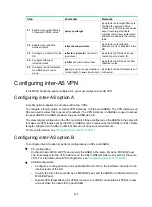
231
Step Command
Remarks
3.
Configure match criteria for
the node.
See
Layer 3—IP Routing
Configuration Guide
.
By default, no match criterion is
configured. All packets match the
criteria for the node.
This step matches packets from
the multirole host.
4.
Specify the VPN instances
for forwarding the matching
packets.
apply access-vpn vpn-instance
vpn-instance-name
&<1-n>
By default, no VPN instance is
specified.
You must specify multiple VPN
instances for the node. The first
one is the VPN instance to which
the multirole host belongs, and
others are the VPN instances to
be accessed by the multirole host.
A matching packet is forwarded
according to the routing table of
the first VPN instance that has a
matching route for that packet.
The value for
n
is 4.
5.
Return to system view.
quit
N/A
6.
Enter the view of the
interface connected to the
CE.
interface
interface-type
interface-number
N/A
7.
Apply the policy to the
interface.
ip policy-based-route
policy-name
By default, no policy is applied to
the interface.
Configuring a static route
Step Command
Remarks
1.
Enter system view.
system-view
N/A
2.
Configure a static route
for a VPN instance to
reach the multirole host.
ip route-static
vpn-instance
s-vpn-instance-name
dest-address
{
mask-length
|
mask
}
vpn-instance
d-vpn-instance-name
next-hop-address
[
track
track-entry-number
]
[
permanent
] [
preference
preference
]
[
tag
tag-value
] [
description
text
]
By default, no static routes are
configured.
The
d-vpn-instance-name
argument represents the VPN
instance to which the multirole
host belongs. The
next-hop-address
argument
represents the IP address of
the CE in the site where the
multirole host resides.
Configuring HoVPN
In a HoVPN networking scenario, perform basic MPLS L3VPN settings on UPE and SPE. In addition,
configure the following settings on the SPE:
•
Specify the BGP peer or peer group as a UPE.
•
Advertise the default route of the specified VPN instance or routes matching a routing policy to
the UPE.
•
Create a BGP-VPN instance so the learned VPNv4 routes can be added into the BGP routing
table of the corresponding VPN instance by comparing RTs.
















































